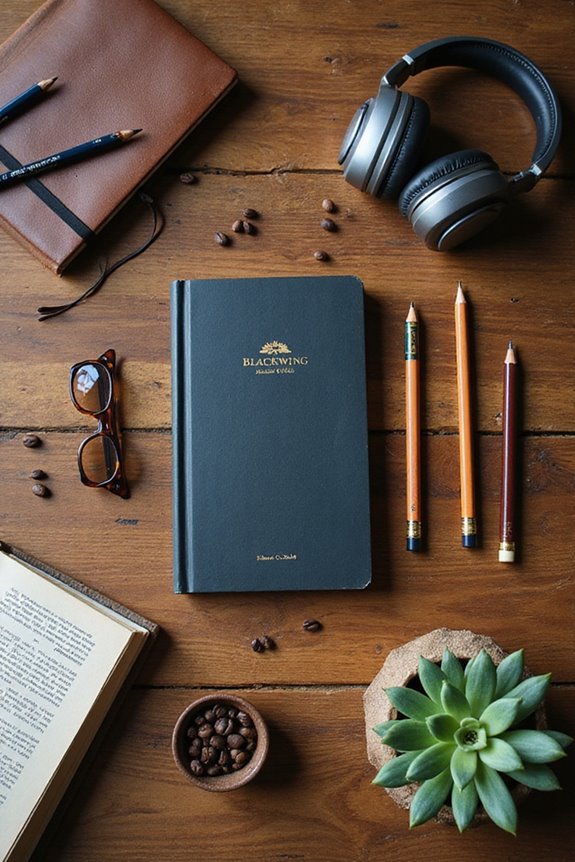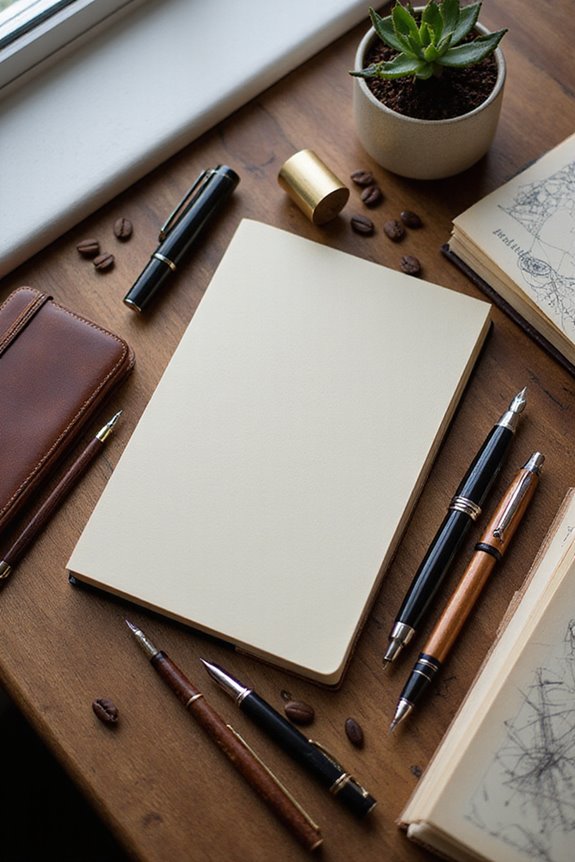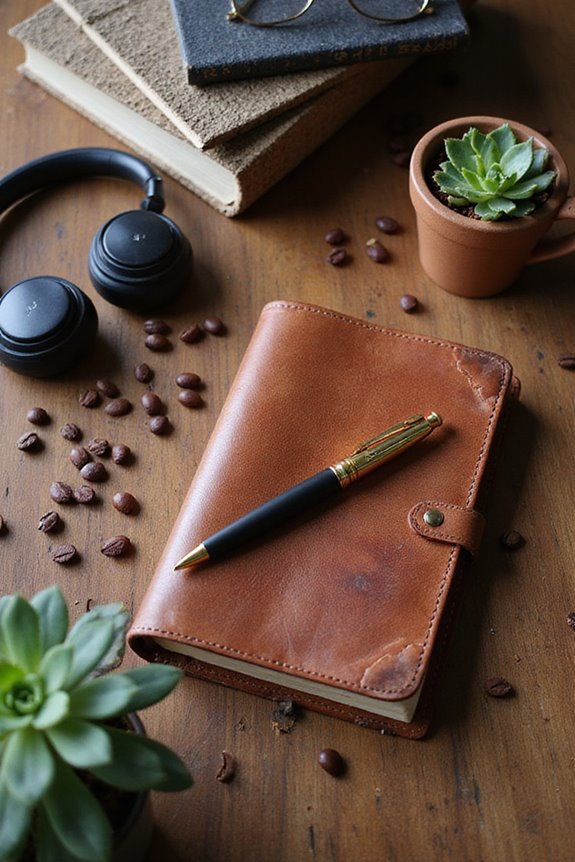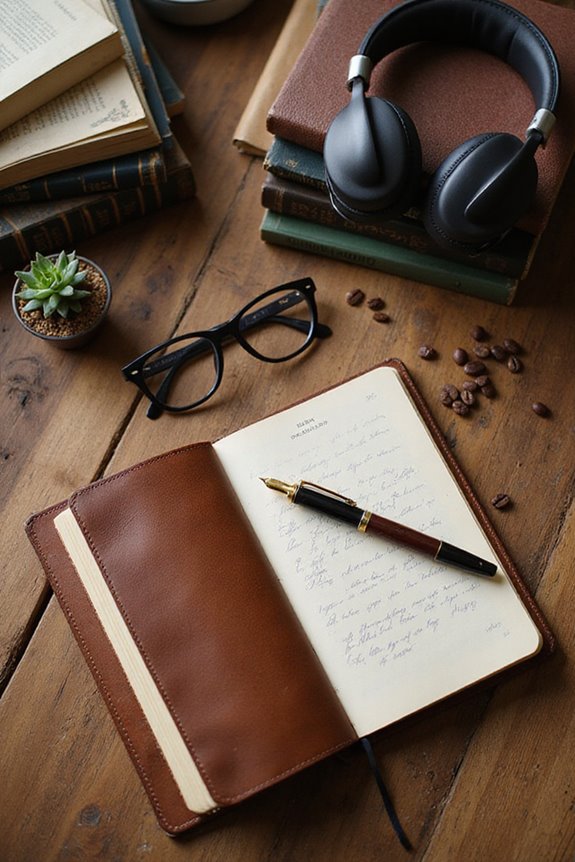When we choose pencils, we’ve got a world of options! For artists, softer pencils like Faber-Castell’s 4B or Derwent Graphic are perfect for rich, dark lines and shading, while technical artists might prefer harder grades like 2H for precision. Don’t forget everyday writers—we’d recommend the Musgrave Tennessee Red for smooth writing. Experimenting with different brands can really help hone your skills, so let’s explore even more options and techniques to find what works best for you!
Key Takeaways
- Artists often choose Faber-Castell Castell 9000 and Derwent Graphic pencils for their versatility and smooth application in drawing and shading.
- Softer pencils (e.g., 4B to 8B) are preferred for expressive work, while harder pencils (e.g., 2H) are used for technical precision.
- Woodless options like Cretacolor Monolith provide high graphite content, ideal for rich dark marks without wood interference.
- Quality writing pencils such as Mitsubishi 9852 offer ergonomic designs and smooth performance for everyday use in writing tasks.
- Proper grip techniques enhance artistic control, impacting line quality and fatigue during prolonged use while drawing or writing.
Types of Pencils for Artistic Expression
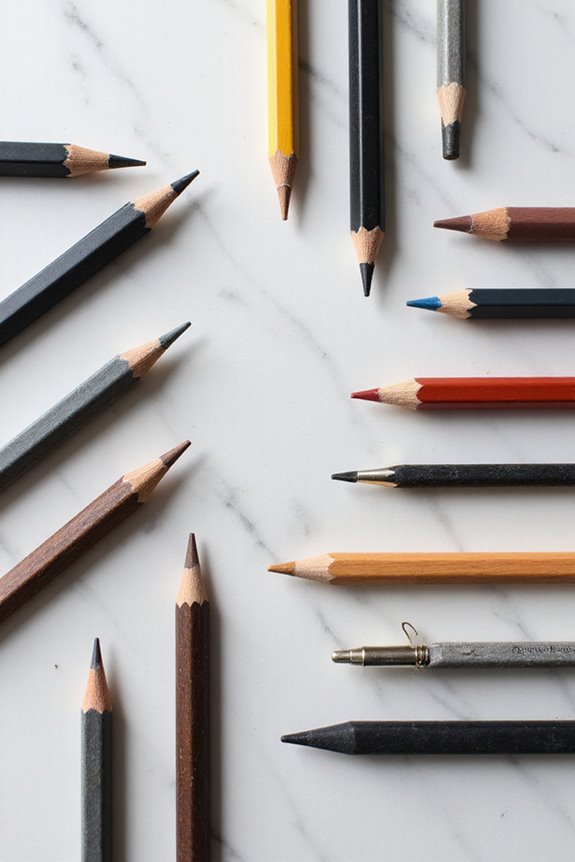
When we think about pencils for artistic expression, we can’t overlook the variety available that caters to different styles and techniques. For instance, the Faber-Castell Castell 9000 range gives us options from 8B to 6H, perfect for varied pencil techniques. If we prefer smooth drawing, Staedtler Mars Lumograph delivers consistent graphite ideal for blending methods and mid-tone work. For stronger lines, the Cretacolor Monolith woodless pencils shine, offering high graphite content without the wooden casing. Soft pencils, like those from Derwent Graphic, excel in shading, while harder grades, like Caran d’Ache Grafwood, help with precision. Choosing the right pencil not only enhances our art but also can streamline our creative process. Let’s experiment and find our favorites!
Understanding Graphite Pencil Hardness
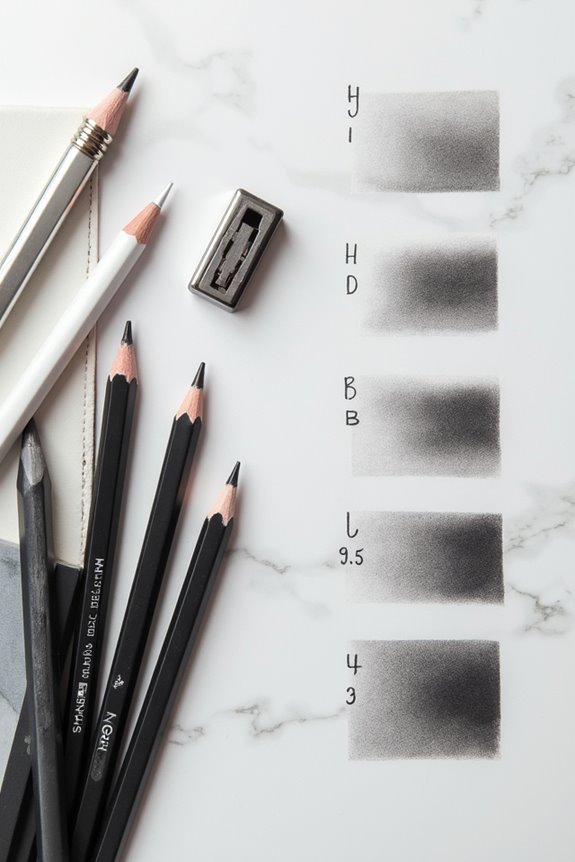
Understanding the hardness of graphite pencils can really enhance our artistic and writing experiences. When we look at graphite grades, we can choose between two systems: numeric and HB scales. For instance, in the HB scale, “H” shows hardness while “B” indicates softness. Softer pencils, like 4B, create darker marks but wear out quickly, perfect for artistic shading. Conversely, harder pencils, such as 2H, make lighter marks and resist smudging, ideal for technical drawings. If we want the best of both worlds, we can opt for F-grade pencils, which sharpen to a fine point. So, next time we grab a pencil, think about the different pencil hardness to suit our needs, whether we’re sketching or writing!
Popular Pencil Brands Among Artists
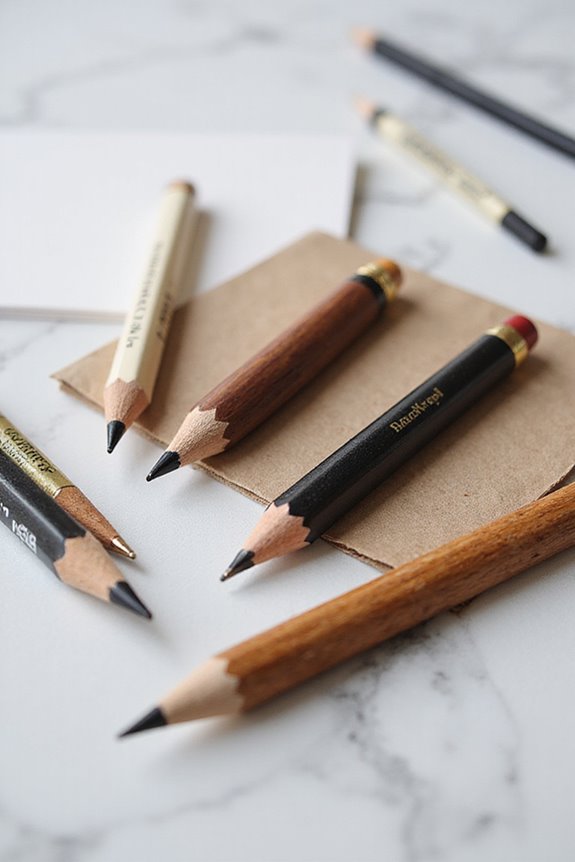
While we explore the world of pencil brands, it is essential to recognize that the right tools can elevate our artistry. When looking at pencil brand comparisons, we’ve come across some favorites among artists. For graphite, the Faber-Castell 9000 Series stands out for its quality and versatility, while Derwent Graphic Pencils are loved for their smooth laydown. Colored pencil enthusiasts often opt for Faber-Castell Polychromos, known for their rich pigments. If we’re on a budget, brands like Koh-i-Noor Toison d’Or provide professional quality without breaking the bank. Ultimately, our artist preferences may vary, but trying a few brands can help us discover what works best for us. Remember, it’s all about enhancing our creative journey!
Choosing Pencils Based on Artistic Style
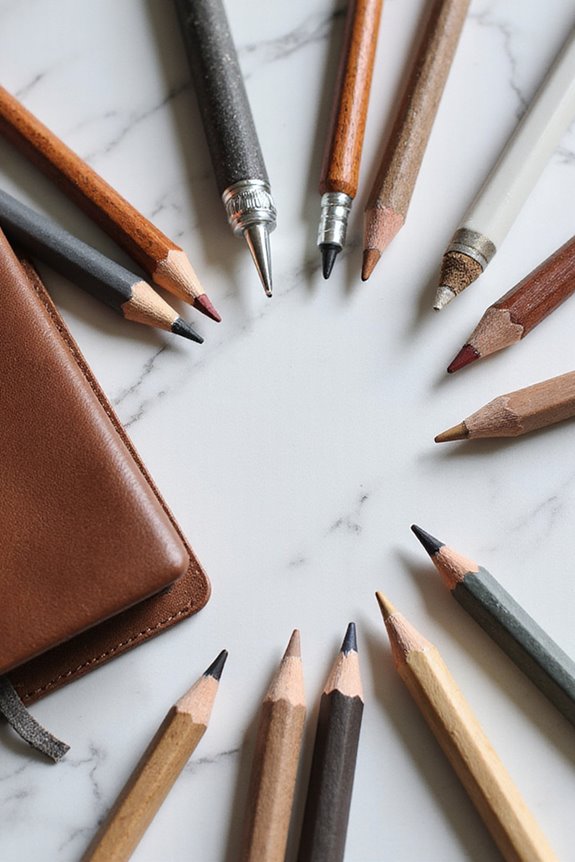
How do we choose the right pencils to match our artistic style? First, let’s consider our style preferences. For expressive work, softer pencils like 4B or 6B deliver rich, dark lines perfect for shading. If we lean toward realism, a range of hardness from HB to 8B helps capture fine details and tonal variation. Technical artists often opt for harder pencils, like H or 2H, for those precise lines. Charcoal pencils can also elevate our bold techniques, offering deep blacks and dramatic contrasts. Don’t forget about blending tools—they can enhance our sketches! Experimenting with various pencils based on our unique artistic techniques can lead to fantastic results, so let’s explore and find what resonates with us!
Essential Writing Pencils for Everyday Use
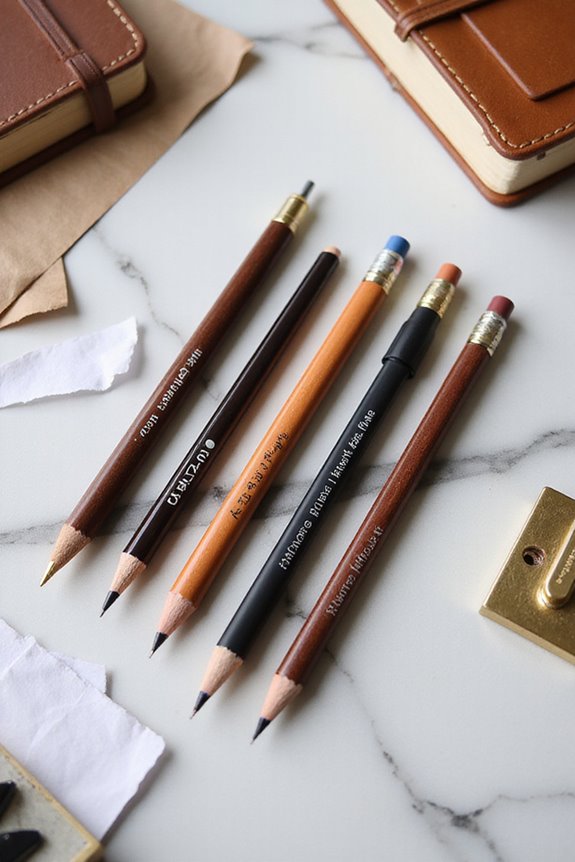
When it comes to choosing essential writing pencils for everyday use, we want to find options that are both reliable and comfortable. For starters, the Musgrave Tennessee Red is an affordable option at just $0.50 per pencil, making it perfect for note-taking. If you prefer something a bit classier, the Mitsubishi 9852 “Master Writing” offers an ergonomic design, balancing comfort and a good eraser. Another solid choice is the Palomino Forest Choice; it delivers a pleasant tactile feel without breaking the bank. Look for pencils with an HB rating for smooth writing. Remember, your writing experience will benefit from quality wood casing and a comfortable grip, making those long study sessions a little less intimidating. Let’s elevate our writing game!
Mechanical Pencils: Precision and Convenience
Mechanical pencils have become nearly indispensable tools for artists and writers alike, offering a delightful blend of precision and convenience. With lead sizes ranging from 0.2mm to 0.9mm, we can choose the right lead type for our writing techniques. For ultra-fine details, we love using 0.3mm lead, which creates sharp lines with minimal smudging. On the other hand, 0.5mm lead strikes a great balance for both sketching and writing. The push-button advance mechanism is a lifesaver, keeping our creativity flowing without interruptions. Plus, these pencils are refillable, which means we can keep going without the hassle of constant sharpening. So grab your favorite model, and let’s explore the world of ideas!
Charcoal and Pastel Pencils for Bold Effects
While mechanical pencils offer incredible precision, sometimes we crave a bit more flair in our artwork or writing. That’s where charcoal and pastel pencils come into play! These mediums create bold, dramatic effects that can really make our pieces pop. With charcoal techniques, we can effortlessly create deep shadows and rich textures; just smudge, layer, or use a blending stump to achieve those stunning contrasts.
On the other hand, pastel blending allows vibrant colors to dance together on the page, producing a soft, atmospheric touch. Imagine swirling yellows and pinks to depict a sunrise! Whether we’re sketching or coloring, experimenting with these pencils can elevate our artistic expression considerably. So let’s plunge into and explore what these tools can do for our creative endeavors!
Tools and Accessories for Pencil Mastery
To master the art of pencil drawing and writing, we’ve got a treasure trove of tools and accessories at our fingertips! First up, let’s talk about eraser types. Soft art erasers gently correct mistakes without damaging the paper, while kneaded erasers let us lift graphite to lighten areas or create subtle highlights.
Now, blending techniques are essential too. Using paper blending tools like stumps helps us soften harsh lines and achieve smooth gradients. Plus, if we need precision, eraser shields protect surrounding areas during selective erasing.
Finally, don’t underestimate the power of quality sharpeners—whether hand-crank or battery-operated—they maintain sharp tips for ideal artistry. With the right tools, our pencil skills can truly shine!
The Importance of Paper Choice
When it comes to pencil drawing and writing, the choice of paper is like the canvas for a painter—it’s essential. Selecting the right paper texture directly impacts our pencil’s grip and layering capabilities. For instance, smoother sheets like Bristol smooth are great for fine details, while rougher textures, like Strathmore 400 Series Pastel Paper, excel in creating depth for portraits. Don’t forget about archival quality; papers like 100% cotton from Arches withstand erasures and resist yellowing over time. For balanced use, medium-textured options provide a sweet spot for both blending and layering, helping us achieve our artistic goals. So, whether we’re sketching or finalizing a piece, choosing the right paper can enhance our work immensely!
Maintaining and Sharpening Pencils
Choosing the right paper sets the stage for our pencil work, but equally important is how we maintain and sharpen our pencils for peak performance. We can use several pencil maintenance techniques to guarantee our tools stay in top shape. For sharpening methods, hand-sharpening with a knife gives us the power to control point size and shape. Mechanical pencils are handy too, assuring needle-sharp points without excess waste. After we sharpen, it’s essential to clean our colored pencils with a soft paintbrush—this keeps colors vibrant. Remember, a relaxed grip is key! It helps prevent fatigue and allows for better control. Let’s take care of our pencils, and they’ll help us create stunning art and writing for a long time!
Frequently Asked Questions
What Pencil Should Beginners Start With for Drawing?
For beginners starting with drawing, we recommend a mix of softer and harder graphite types. It’ll help us master sketching techniques, balancing light and dark lines effectively while building our confidence in our artistic journey.
How Long Do Artist-Grade Pencils Last?
When considering pencil longevity, we find that artist preferences play a significant role. Depending on usage and care, artist-grade pencils can last from several months to years, ensuring vibrant and enduring artistry throughout their life.
Can I Use Color Pencils for Shading?
Absolutely, we can use color pencils for shading! With over 70 different color pencil techniques, blending and layering through various shading methods creates depth and richness, enabling us to achieve stunning results in our artwork.
What Type of Eraser Is Best for Pencil Work?
When it comes to eraser types for pencil work, we find kneaded erasers great for gentle lifting, while rubber erasers excel in clean removals. It really depends on our specific needs for each project!
Are There Eco-Friendly Pencil Options Available?
Absolutely, we can find eco-friendly pencil options! Many use sustainable materials, like recycled paper and graphite. These choices not only write smoothly, but also support a greener planet, making them ideal for conscious consumers like us.

